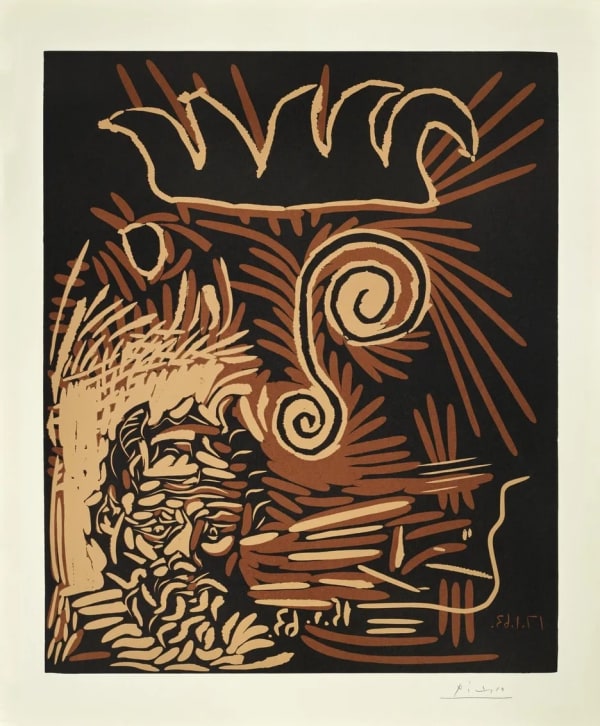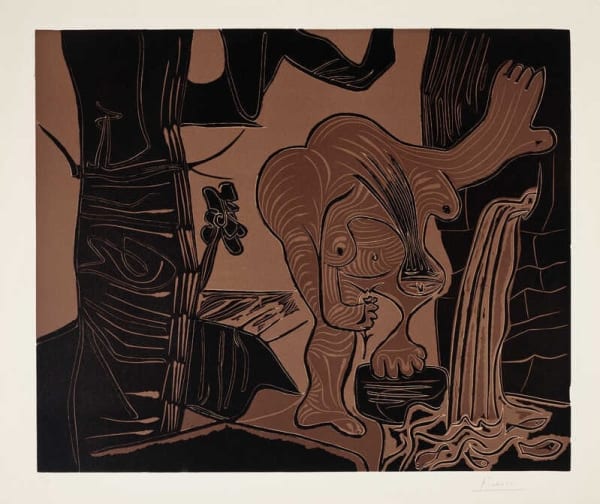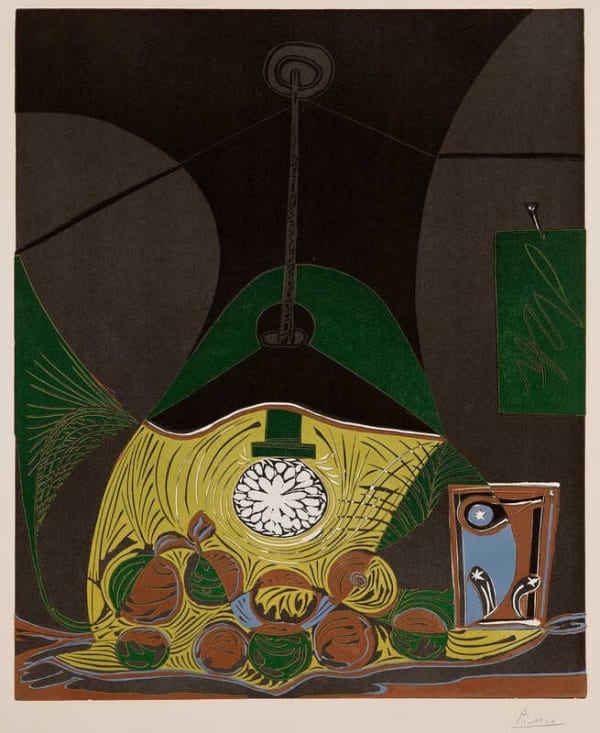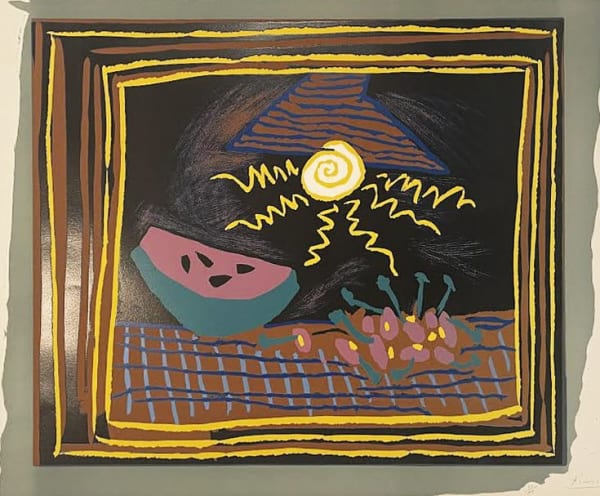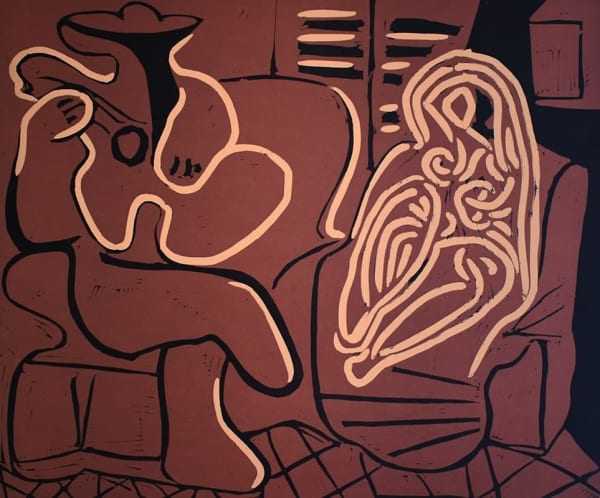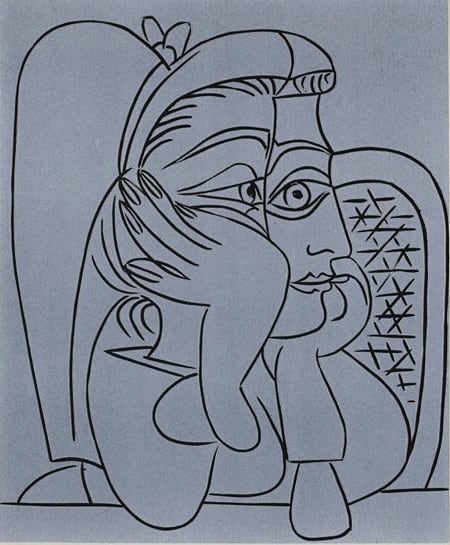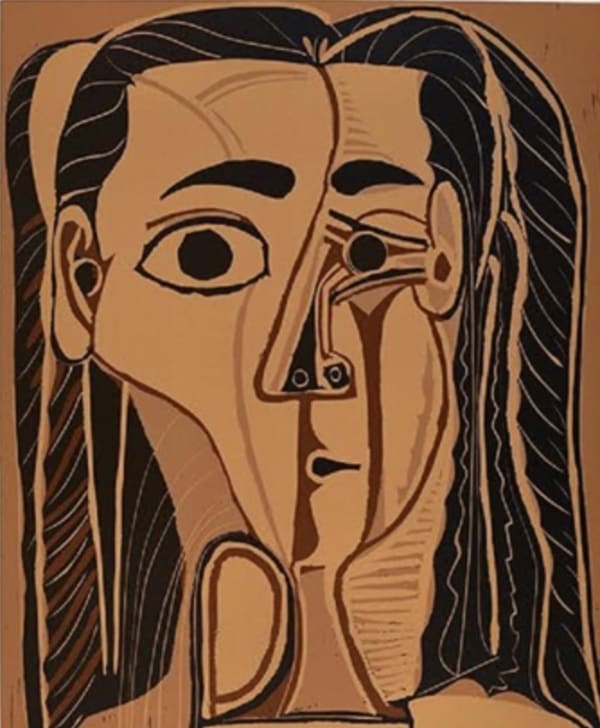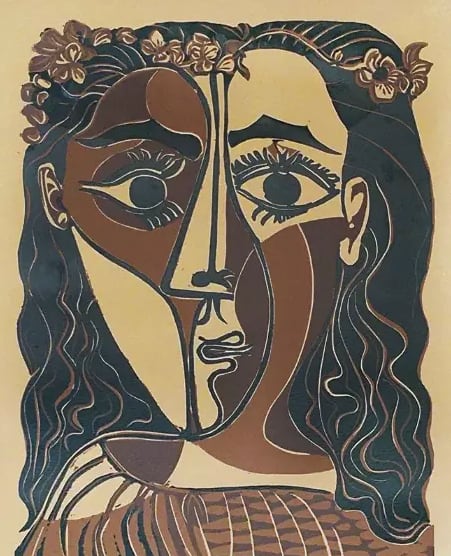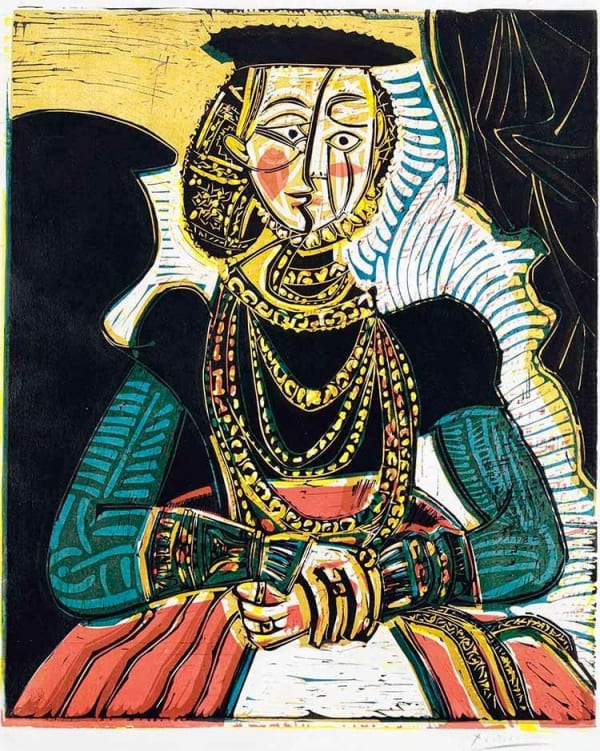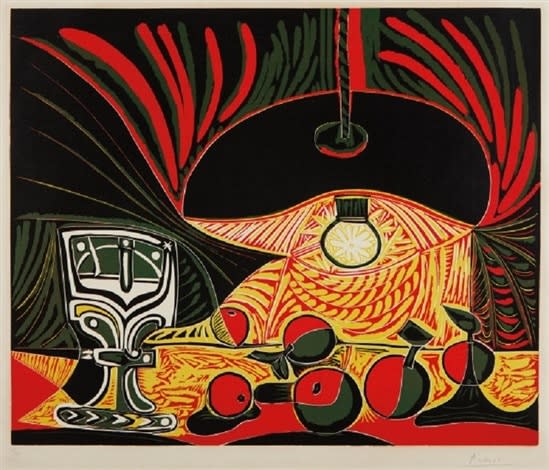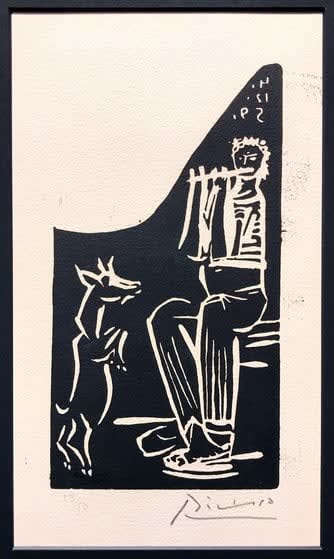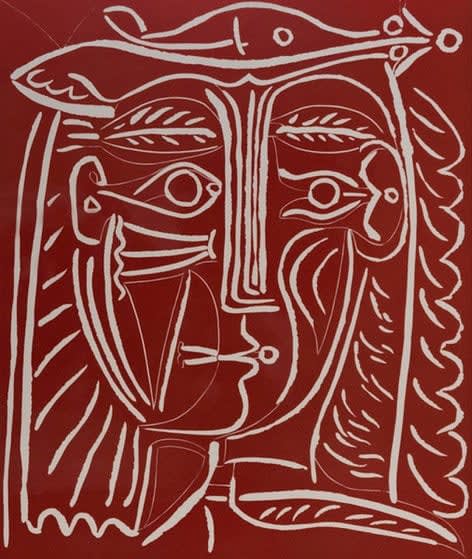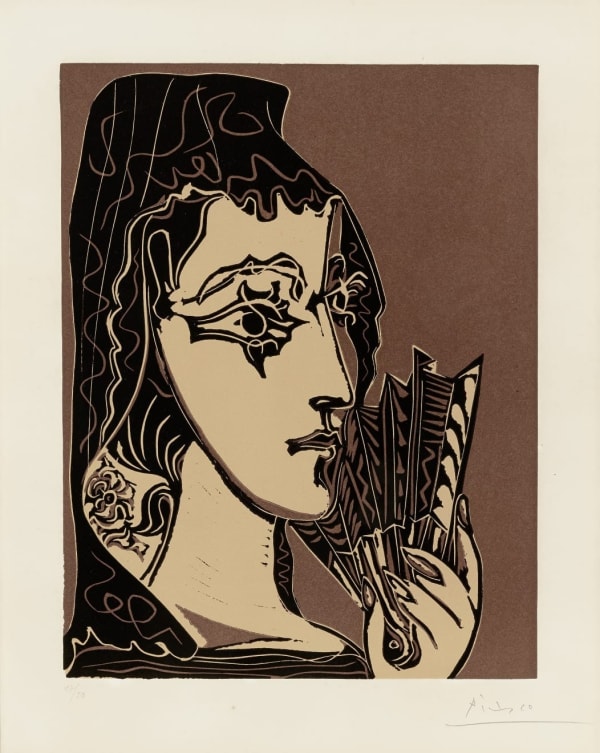
Pablo Picasso
This work is hand-signed by Pablo Picasso (Malaga, 1881- Mougins, 1973) in pencil in the lower right margin.
62.2 x 74.9 cm
This 1959 linocut by Pablo Picasso, Bacchanale au Taureau Noir, is a vivid example of the artist’s late printmaking, where his bold use of color and form transforms a classical theme into a modernist celebration of rhythm, vitality, and myth. Executed in strong tonal contrasts on Arches paper, the work demonstrates Picasso’s technical mastery of linocut as well as his ability to infuse age-old subjects with fresh immediacy.
By the late 1950s, Picasso had elevated the linocut—previously regarded as a secondary printmaking process—into a medium of radical invention. Working with the printer Hidalgo Arnéra in Vallauris, Picasso perfected the reduction method, cutting and re-cutting a single linoleum block in successive stages to create multi-colored compositions. In Bacchanale au Taureau Noir, this method produces strikingly flat but vibrant planes of color: deep green for the earth, light blue for the sky and water, and sandy ochres for the dancing figures.
Printed on Arches paper, prized for its strength and fine texture, the linocut achieves both richness and crisp clarity. The bold, clean edges of form highlight Picasso’s precision, while the interplay of flat color and graphic line creates a visual language that is both monumental and playful.
The scene is structured around a central group of figures engaged in dance and music. Two ochre-colored dancers move rhythmically at the water’s edge, their bodies reduced to essential, dynamic forms. To the right, a seated musician plays a pipe, his elongated figure drawn in stark black outline. On the left, the imposing silhouette of a black bull anchors the composition, introducing an element of mythic power.
Above, three stylized white clouds float across the sky, their abstract, almost calligraphic forms echoing the curves of the dancers below. This repetition of rhythm between sky and earth unifies the composition, creating a harmony between environment and human action.
The overall effect is one of vitality and ritual: human figures and animal presence are integrated into a timeless bacchanalian scene, celebrating music, movement, and the natural world.
Bacchanale au Taureau Noir illustrates Picasso’s genius for adapting technique to subject. Where his earlier etchings, such as Accouplement I (1933), emphasized density and texture, here he exploits the linocut’s clarity and immediacy. The reduction of forms to bold silhouettes and flat planes of color distills the scene to its most essential gestures—dancing, playing, listening, observing.
This economy of means is deceptive: the layering of colors in precise sequence, without room for correction, required both technical mastery and extraordinary confidence. The result is a work that appears spontaneous and playful while resting on a foundation of meticulous execution.
The subject of the bacchanal—a gathering of revelers associated with the god Dionysus—had long fascinated Picasso. Here, the inclusion of the black bull connects the scene to Spanish culture and mythology, merging classical antiquity with Picasso’s personal iconography. The bull, a recurring motif in his work, stands for virility, power, and elemental force, qualities that resonate with the themes of the bacchanal.
By the late 1950s, Picasso was in his late seventies, yet his printmaking output was extraordinary in both volume and innovation. Works like Bacchanale au Taureau Noir demonstrate not only his enduring fascination with the human body, myth, and ritual but also his continued willingness to reinvent artistic media.
Bacchanale au Taureau Noir is a superb demonstration of Picasso’s late printmaking mastery. Through the linocut’s stark graphic power and vibrant color, he transforms a timeless theme into a modern visual statement. It embodies his lifelong dialogue with mythology, his deep connection to Spanish symbols like the bull, and his ability to reduce form to its essentials without sacrificing vitality or expressive depth.
-
 Pablo PicassoTwo Women by the Window | Deux femmes près de la fenêtre, 1959
Pablo PicassoTwo Women by the Window | Deux femmes près de la fenêtre, 1959 -
 Pablo PicassoWoman Reclining and Man with a Guitar | Femme couchée et homme à la guitare, , 1959
Pablo PicassoWoman Reclining and Man with a Guitar | Femme couchée et homme à la guitare, , 1959 -
 Pablo PicassoJacqueline au chapeau de paille, 1962
Pablo PicassoJacqueline au chapeau de paille, 1962 -
 Pablo PicassoLe Vieux bouffon, 1963
Pablo PicassoLe Vieux bouffon, 1963 -
 Pablo PicassoHomme au batôn / Le Vieux bouffon, 1963
Pablo PicassoHomme au batôn / Le Vieux bouffon, 1963 -
 Pablo PicassoFemme nue à la source, 1963
Pablo PicassoFemme nue à la source, 1963 -
 Pablo PicassoNature morte à la suspension, 26 mars, 1962
Pablo PicassoNature morte à la suspension, 26 mars, 1962 -
 Pablo PicassoTaureau et Picador, 1959
Pablo PicassoTaureau et Picador, 1959 -
 Pablo PicassoFemme au Chapeau (Portrait de Jacqueline au chapeau de paille multicolore)., 1962
Pablo PicassoFemme au Chapeau (Portrait de Jacqueline au chapeau de paille multicolore)., 1962 -
 Pablo PicassoLe Déjeuner sur l'herbe d'aprés Edouard Manet. (The Luncheon on the Grass after Edouard Manet), 1954
Pablo PicassoLe Déjeuner sur l'herbe d'aprés Edouard Manet. (The Luncheon on the Grass after Edouard Manet), 1954 -
 Pablo PicassoBoy with a Crown of Leaves | Jeune homme couronné de feuillage, 1959
Pablo PicassoBoy with a Crown of Leaves | Jeune homme couronné de feuillage, 1959 -
 Pablo PicassoLe Vieux Roi (B. 1152) (The Old King) , 1963
Pablo PicassoLe Vieux Roi (B. 1152) (The Old King) , 1963 -
 Pablo PicassoNature Morte a la Pasteque, 1962
Pablo PicassoNature Morte a la Pasteque, 1962 -
 Pablo PicassoAubade, with a Woman in an Armchair | L'aubade, avec femme dans un fauteuil, 1959
Pablo PicassoAubade, with a Woman in an Armchair | L'aubade, avec femme dans un fauteuil, 1959 -
 Pablo PicassoL'Aubade, avec Femme Accoudee, 1959
Pablo PicassoL'Aubade, avec Femme Accoudee, 1959 -
 Pablo PicassoLes vendangeurs, 1959
Pablo PicassoLes vendangeurs, 1959 -
 Pablo PicassoFemme Accoudée (Bloch 922) , 1959
Pablo PicassoFemme Accoudée (Bloch 922) , 1959 -
 Pablo PicassoGrande Tete De Femme (Bloch 1069), 1962
Pablo PicassoGrande Tete De Femme (Bloch 1069), 1962 -
 Pablo PicassoPetite Tête de Femme Couronnée, `962
Pablo PicassoPetite Tête de Femme Couronnée, `962 -
 Pablo PicassoBuste de Femme d'après Cranach le Jeune, (Bloch 859), 1958
Pablo PicassoBuste de Femme d'après Cranach le Jeune, (Bloch 859), 1958 -
 Pablo PicassoPortrait de Jacqueline Accoudée, 1959
Pablo PicassoPortrait de Jacqueline Accoudée, 1959 -
 Pablo PicassoJacqueline au Bandeau, 1962
Pablo PicassoJacqueline au Bandeau, 1962 -
 Pablo PicassoNature Morte Au Verre Sous La Lampe, 1962
Pablo PicassoNature Morte Au Verre Sous La Lampe, 1962 -
 Pablo PicassoPortrait de Jacqueline Au Chapeau De Paille Fleuri, 1962
Pablo PicassoPortrait de Jacqueline Au Chapeau De Paille Fleuri, 1962 -
 Pablo PicassoLa Pique en Rouge et Jaune (The Bullfight in Red and Yellow), 1959
Pablo PicassoLa Pique en Rouge et Jaune (The Bullfight in Red and Yellow), 1959 -
 Pablo PicassoNu Assis, 1962
Pablo PicassoNu Assis, 1962 -
 Pablo PicassoPortrait De Jacqueline (Bloch 923), 1959
Pablo PicassoPortrait De Jacqueline (Bloch 923), 1959 -
 Pablo PicassoPortrait de Femme a la Fraise et au Chapeau , 1962
Pablo PicassoPortrait de Femme a la Fraise et au Chapeau , 1962 -
 Pablo PicassoL'Etreinte (Bloch 1150), 1963
Pablo PicassoL'Etreinte (Bloch 1150), 1963 -
 Pablo PicassoFaune et Chévre, 1959
Pablo PicassoFaune et Chévre, 1959 -
 Pablo PicassoJacqueline au Bandeau, 1962
Pablo PicassoJacqueline au Bandeau, 1962 -
 Pablo PicassoWatermelon Still Life, 1962
Pablo PicassoWatermelon Still Life, 1962 -
 Pablo PicassoDeux Femmes Prés de la Fenêtre , 1959
Pablo PicassoDeux Femmes Prés de la Fenêtre , 1959 -
 Pablo PicassoBacchanale au Hibou (bloch 938), 1959
Pablo PicassoBacchanale au Hibou (bloch 938), 1959 -
 Pablo PicassoTête de Femme au Chapeau , 1962
Pablo PicassoTête de Femme au Chapeau , 1962 -
 Pablo PicassoPortrait de Jacqueline en Carmen (L'Espagnole) , 1962
Pablo PicassoPortrait de Jacqueline en Carmen (L'Espagnole) , 1962
Join our mailing list
* denotes required fields
We will process the personal data you have supplied in accordance with our privacy policy (available on request). You can unsubscribe or change your preferences at any time by clicking the link in our emails.
This website uses cookies
This site uses cookies to help make it more useful to you. Find out more about cookies.



